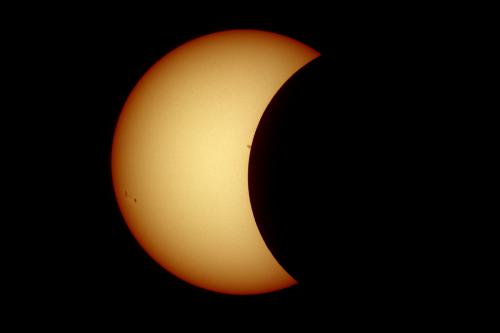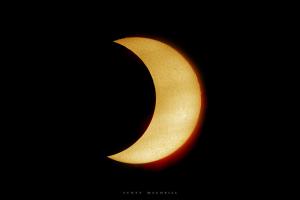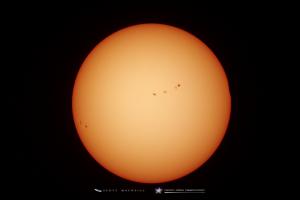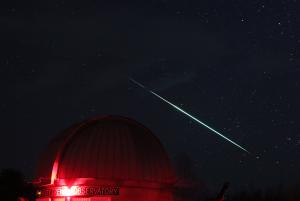Celebration of Space - October 13, 2023

The Solar Eclipse of August 2017 at Frosty Drew Observatory. Image Credit: Frosty Drew Astronomy Team member, Scott MacNeill.
Tomorrow, Saturday, October 14, 2023 will bring a stunning annular solar eclipse to the United States. An annular eclipse occurs when the Moon is not close enough to Earth to block the entire Sun from our view. This will leave a ring of Sun around the Moon, commonly referred to as a ring of fire. But there isn’t any fire on the Sun, so it is somewhat of an inaccurate moniker. Regardless of what you call the event, the view will be fascinating.
For those who are not sure, a solar eclipse always occurs on the date of the new Moon. During this phase, the Moon will orbit to a position that is between the Earth and the Sun. We call this “conjunction”. It is the new Moon that will obscure, or block, our view of the Sun during a solar eclipse. The question you may have is, why doesn’t this happen every 29.5 days (lunar synodic cycle)? This is because the Moon orbits Earth 5.1° inclined to the ecliptic. The ecliptic is the path the Sun takes across the sky, and represents the plane of the Solar System. What all this means is that the Moon, during the new phase, can visibly pass within 5.1° above or below the Sun. But about twice per year, the Moon will orbit close enough to the ecliptic to actually block our view of some, or all, of the Sun. Your location on Earth matters as well, both on the basis of angular view, and lunar rise and set times.
Another question you may have is why are some eclipses annular and others total? The answer to this question comes down to a measure of the deviation from a perfect circle in the Moon’s orbit, called “eccentricity”. The Moon’s orbit has an eccentricity of 0.0554. An eccentricity of 0 is a perfect circle, and eccentricity of 0-1 is an ellipse, and an eccentricity of 1 is a parabola. Due to this eccentricity in the Moon’s orbit, the Moon has a close point (perigee) and far point (apogee) in its orbit. When the solar eclipse happens near the lunar perigee, then the Moon will completely eclipse the Sun. Alternatively, if a solar eclipse happens during or near the lunar apogee, then the Moon will not fully eclipse the Sun, leaving a ring of Sun visible around the Moon. This month, the lunar apogee occurred this past Tuesday, October 10th.
At Frosty Drew, the eclipse will be visible as a partial eclipse. The Moon will enter the visible area of the Sun at 12:15 pm ET, and will continue to orbit into the path of sunlight until it reaches maximum eclipse, which will happen at 1:26 pm ET, with 19.11% of the Sun becoming eclipsed by the Moon. After which, the Moon will begin to depart the visible area of the Sun, with the eclipse ending at 2:35 pm ET. If setting out to observe the eclipse, you will absolutely need adequate eye protection to observe all stages of this eclipse. This can come in the form of solar filters for a camera, telescope, or binoculars, or via eclipse glasses. At Frosty Drew we are hosting an event for the eclipse and will have several viewing devices, including telescopes, projectors, and live streams. At this time, the weather is not looking too good, and if it is too cloudy, we will show a live stream from somewhere along the line of the annular eclipse. Learn more about our event.
If you have eclipse glasses left over from a previous eclipse, they may still be usable, even if they have an expiration date on them. To confirm if your old eclipse glasses are usable, check out our video on YouTube about testing your eclipse glasses.
If you have a clear sky when observing the eclipse, depending on your viewing equipment, you may be able to see several sunspots. The Sun is reaching the most active period of the eleven year solar cycle, called Solar Maximum, which will bring the most intense sunspot activity. Currently, there are several excellent sunspot groups visible on the Sun, with sunspot group AR3465 putting on quite a show, and potentially large enough to be seen with just eclipse glasses. Sunspots will appear exactly as the name suggests – as small dark spots on the Sun. Now step out early tomorrow afternoon and see if you can spot the partial eclipse.
Over the past few weeks the Southern Taurid Meteor Shower kicked in, and today the North Taurid Meteor Shower starts. Even though neither shower will peak until November, the Taurid showers are very notable. This is because they are known to bring a high number of fireball meteors to the sky, sometimes with fireball meteors happening every night. As we move through the darker nights around the new Moon the opportunity is there to see a fireball meteor just by laying out under the stars. Even if the Moon is out, a fireball meteor is bright enough to be seen. In 2016 Frosty Drew Astronomy Team members, Brian Kelley, and Scott MacNeill observed at least one fireball meteor per night during the late October – mid November time frame. There really isn’t any specific area of the sky to look for fireballs in, aside from up. Though the constellation Taurus should be above the horizon when viewing, as it will bring a much higher chance of seeing a fireball. At this time, Taurus rises around 9:00 pm. Note that sometimes fireball meteors are bright enough to be observed during the day. So keep an eye to the sky over the next month, and perhaps you will see a brilliant fireball meteor. Check out this image of a Taurid fireball over Frosty Drew Observatory, captured by Collin McCarron.
- Author:
- Scott MacNeill
- Entry Date:
- Oct 13, 2023
- Published Under:
- Scott MacNeill's Columns





